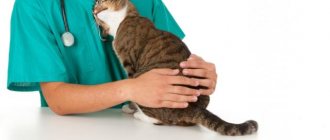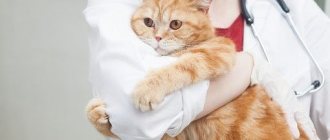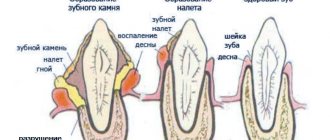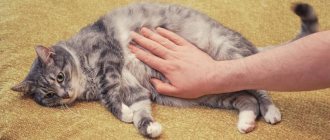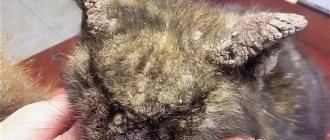Symptoms of mastitis in cats Diagnosis Treatment of mastitis in cats Prevention Mastitis in a cat is an inflammation of the mammary glands. The disease can occur in a chronic or acute form. Usually occurs during lactation (feeding kittens) due to mechanical injury to the glands or infection through skin lesions. It can develop due to early weaning of kittens, after a false pregnancy or estrus. It may also be a consequence of intoxication or postpartum infection. Predisposition to the disease is hereditary.
Symptoms of mastitis in cats
Mastitis in cats may be accompanied by the following symptoms:
- swelling of the mammary glands appears;
- the glands become denser and redden;
- the local temperature of the glands rises, they feel very hot to the touch, sometimes the temperature of the whole body rises;
- the cat does not allow the kittens to touch the nipples;
- the cat often licks sore nipples;
- the consistency and appearance of milk changes;
- milk may be mixed with pus, flakes or blood;
- the activity of the animal decreases;
- appetite decreases;
- The general condition of the cat is lethargic and depressed.
Such symptoms require a mandatory visit to the veterinarian. Often, owners believe that mastitis is not a big deal and will go away on its own, so if the listed signs appear, they postpone a visit to the clinic. However, such symptoms can also be signs of other diseases, in particular mammary tumors, which in cats are very often malignant and quickly metastasize, and if a diagnosis is not made in a timely manner, time for treatment can be irreparably lost. Mastitis also most often requires treatment; the inflammatory process develops quickly and can cause serious complications.
Advanced mastitis can lead to the formation of abscesses (purulent inflammation).
When mastitis occurs, the milk becomes contaminated and unsuitable for feeding kittens; at the first symptoms, it is recommended that they be switched to artificial feeding. This will also help avoid additional injury to sore nipples.
With chronic mastitis, clinical symptoms may not clearly manifest themselves, the cat’s well-being will be within normal limits, and visible changes in the mammary glands may not occur or it will be very weak. The symptom in this case may be disturbances in the functioning of the gastrointestinal tract (primarily diarrhea) in kittens, and sometimes death.
Stages of the disease
Mammary cancer that occurs in a cat has four stages of development. They are recognized by their clinical signs and have different courses:
- The first stage is characterized by small, painless lumps. The lymph nodes are not yet enlarged. The disease detected at this stage can be completely cured, and the cat continues to live.
- The second stage is characterized by a more dense neoplasm, which can reach a diameter of three centimeters. The tumor at this stage is operable, animals have an approximately one-year survival rate.
- The third stage is a tumor larger than three centimeters in size, inflamed lymph nodes. The cat protects the chest, experiencing pain in the affected area.
- The fourth and final stage cannot be cured. The neoplasm is significant in size. Lymph nodes are greatly enlarged. The cat is exhausted. There are already metastases. In most cases, at this stage of the disease, surgery is powerless. Severe pain is relieved by constant use of painkillers. The prognosis of the disease is unfavorable. In especially severe cases, animal euthanasia is used.
The degree of disease in the clinic is determined by the so-called staging system, which takes into account the size of the tumor and the results of aspiration biopsy of the lymph nodes. In addition, to determine the number and localization of metastases, radiography in three projections, ultrasound examination of the abdominal cavity, computed tomography and magnetic resonance imaging are prescribed.
Diagnostics
At the first stage of the disease, there may be no main externally noticeable symptoms (redness, foreign impurities in milk, refusal to feed kittens). However, if you notice unusual lethargy and decreased appetite in a nursing cat, this is a reason to definitely show your pet to a doctor. To diagnose mastitis, it is necessary to conduct an in-person examination and, if necessary, take a general blood test. The sooner mastitis is detected in a cat and treatment is prescribed, the fewer complications there will be and the faster the recovery period will pass.
Establishing diagnosis
As already mentioned, with breast cancer, early diagnosis of the disease is very important, so the owner is required to deliver the animal to a good veterinary facility on time. Only a doctor can make a high-quality diagnosis. He has at his disposal all types of instrumental examinations (ultrasound, radiography, magnetic resonance and computed tomography). In addition, a biopsy or fine needle aspiration (penetration) of the lesion for cytological examination helps to make an accurate diagnosis.
A lot depends on how carefully the biopsy material is taken. Additional trauma to the tumor can lead to a sharp increase in the number of metastases, which will make the patient's condition more severe. The inguinal and axillary lymph nodes must be examined, since they are also often affected by the disease.
In this case, a detailed blood test, including its biochemical formula, is no less informative. It will allow you to determine the degree of the inflammatory process, as well as the presence of concomitant infections, which cannot be ignored when prescribing a treatment regimen.
Treatment of mastitis in cats
With timely treatment, treatment is therapeutic, the prognosis is favorable and the cat will recover quickly. The doctor may prescribe antipyretics, antibiotics, and medications that reduce milk production. The prescribed treatment depends on the causes of mastitis (in addition to genetic predisposition and trauma during feeding, it can also be trauma to the mammary glands, other past diseases, stagnation of milk during early weaning of kittens or excessive lactation), as well as on concomitant pathologies.
Treatment of mastitis in cats at home is completely impossible, since, firstly, the owner cannot be sure of the diagnosis (very often the early stages of mammary gland tumors are confused with mastitis, as a result of which the timely treatment of this serious disease is delayed and the prognosis is significantly worsens), and secondly, treatment for mastitis can vary significantly depending on the cat’s history, age, condition, stage of the disease and additional pathologies. However, it is quite possible to treat at home as prescribed by a doctor, if surgical intervention is not required.
Video about feline mastitis - interview with a reproductive specialist:
The use of “folk” remedies - rubbing, cabbage leaves - is not recommended. At best, they will not have an effect, but will not cause any harm; at worst, hoping for their effectiveness can trigger the disease and, as a result, result in a much more serious condition requiring long-term treatment.
With advanced mastitis in cats, when treatment was not started on time, abscesses may occur that require surgical intervention - opening, drainage, daily sanitation of the abscess cavity.
Feline mammary hyperplasia
Feline mammary hyperplasia or fibroadenomatosis, or fibroepithelial mammary hyperplasia. This pathology has many names, but most often it is known as feline fibroadenomatosis (abbreviated as FAM)
. Its essence lies in the rapid and excessive growth of breast tissue under the influence of the hormone progesterone. All packages can be affected, but more often individual ones. The mammary glands can grow quickly, reaching a size of 5-8 cm. With a large volume of the gland, the skin covering it is damaged, it becomes thinner and defects appear - open wounds, which can become a source of infection. The overgrown tissue itself is also damaged; vascular thrombosis leads to the formation of foci of necrosis. If the pathological process is not treated, the animal may die due to massive infection and systemic inflammation from FAM.
It is worth considering that fibroadenomatous hyperplasia is not lactation, in which there is a moderate increase in gland tissue and there is discharge in the form of milk. Lactation, unlike FAM, occurs during a completely different period of the reproductive cycle, which, if necessary, can be determined by the history of the animal, examination data and hormonal tests. Not every increase in milk supply in cats is FAM
.
The main and only currently proven trigger for the development of FAM is the hormone progesterone.
. Its presence in the body is possible in two cases. After ovulation, the ovaries form the corpus luteum of pregnancy, which secretes progesterone for about 40 days. In the first variant, the cause of the development of fibroadenomatosis is its own, so-called endogenous progesterone. If ovulation was spontaneous, or mating occurred but pregnancy did not occur, FAM can develop in a non-pregnant cat. In some individuals, FAM develops during pregnancy. The second option is when the animal receives progesterone from the outside. These could be progestin-based contraceptive drugs for cats (Perlutex, Covinan, Depo-Provera, Sex Barrier and the like), which are used to suppress heat; or eating/licking drugs taken by the owner (usually the owner - for example, progesterones, which are prescribed to maintain pregnancy, to control reproductive diseases in humans).
Treatment of fabroadenomatosis is possible and available. But to choose the optimal treatment plan
It is important to know where progesterone comes from in the body, whether the animal is valuable in breeding terms, the current state of the milk bags and the animal as a whole. But whatever the reason, the basis of FAM therapy is conservative treatment, the introduction of antiprogestins (drugs that fight the effects of progesterone). Removal of enlarged milk sacs—mastectomy—is not the treatment of choice for fibroadenomatous hyperplasia.
Sterilization is optimal for preventing further relapses even when the volume of milk bags is small. But it will not help if the development of FAM is associated with taking progesterone drugs; surgery will not remove them from the body. And if the volume of mammary gland tissue is significantly increased, when the cat is already in poor condition, there is skin damage, tissue necrosis, surgical intervention will have significant risks. When using long-acting progesterone drugs (for example, Covinan, the effect of which lasts up to six months), therapy may be required throughout the entire period while the drug is present in the body.
If FAM develops during pregnancy, its treatment will lead to loss of pregnancy and abortion/miscarriage, because it is always aimed at combating progesterone, a hormone without which maintaining pregnancy is impossible. In such situations, the question arises: is it possible to carry a pregnancy to term without treatment? Sometimes it's possible. But if, during the process of monitoring a pregnant woman, FAM begins to actively progress, risks to life and health appear, and tactics have to be changed. The mother's life is always a priority.
It is difficult to say whether it is worth removing pedigree cats from breeding
who developed fibroadenomatosis during their first pregnancy. The mechanism of its development, the reasons why this happens in some individuals and not in others, are unknown to us. Hereditary causes of this disease have not been proven. There is a certain breed predisposition in hairless cats, Maine Coons. But it also happens in other breeds, in outbred animals. Some cats do not develop FAM during their second pregnancy. In some cats, FAM develops again on the second attempt, and this becomes a clear reason for sterilization and removal from breeding.
If you notice an increase in milk bags in your cat, this is a reason to contact a fertility specialist. Don't wait until the problem becomes serious and life-threatening. The sooner therapy begins, the lower the risks for the animal.
What is mastopathy
Mastopathy is an insidious disease that is often confused with mastitis, which develops in animals that feed newborn offspring with breast milk. Many owners believe that if their cat is not a nursing mother, then she is not at risk for mammary gland diseases.
Cats have 4 pairs of mammary glands, the main function of which is to produce and secrete breast milk. Cats also have mammary glands that are in an undeveloped state.
Mastopathy is a disease of the mammary glands, characterized by the growth of atypical tissue in it. The pathology is accompanied by severe pain, thirst and progressive exhaustion. The disease is manifested by general engorgement of the mammary glands, the appearance of small or large nodules, swellings, and bumps.
With the benign nature of the disease, small nodes are enclosed in a connective tissue capsule, due to which atypical cells are prevented from merging with nearby healthy tissues. As the tumor grows, compression of the breast tissue, blood vessels and nerves occurs against a background of severe pain. At this stage, the pathology is successfully treated surgically, and the cat continues to live carefree.
When a benign tumor degenerates into a malignant one, atypical cells grow into healthy tissues and metastasize to lymph nodes and distant organs. It is no longer possible to cure animals with cancerous tumors; life can be extended as much as possible with the help of courses of chemotherapy, hormonal and painkillers. Although sometimes in such a situation it is more humane to euthanize an exhausted pet.
Prevention of mastopathy
Prevention of mastopathy in cats involves sterilizing the animal between the ages of 8 months and 2 years. It is not recommended to use contraceptives uncontrolled for a long time in females and males, which have long-term consequences in the occurrence of cancer.
Owners of cats over 6 years of age should regularly examine and palpate their pet's mammary glands for lumps, nodules, or swelling. If you change any milk bags, you should contact your veterinarian.
The advanced form of mastopathy in cats cannot be treated; not only the exhausted pet, but also all family members suffer from oncology. To avoid the development of complications and aggravation of the pathological process, it is worth showing your pet to a doctor at the slightest suspicion of a tumor process. Early diagnosis and timely treatment can prolong the life of your beloved creature.
Taking a biopsy
The process of taking material is not painful for the animal and looks like an injection with a regular syringe. Tumor cells caught in the needle are sent for examination. Having received the results of the study, we can say whether this neoplasm is benign or malignant, and what type it is.
Taking a biopsy does not affect the growth rate of the tumor in any way. Unfortunately, the most common type of tumor in cats is adenocarcinoma. This malignant tumor is prone to relapse (repeated growth after removal) and metastasis (the appearance of foci of tumor growth in organs and tissues distant from the primary sites of detection).
